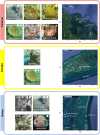The Relationship Between Microbiomes and Selective Regimes in the Sponge Genus Ircinia
- PMID: 33776953
- PMCID: PMC7990798
- DOI: 10.3389/fmicb.2021.607289
The Relationship Between Microbiomes and Selective Regimes in the Sponge Genus Ircinia
Abstract
Sponges are often densely populated by microbes that benefit their hosts through nutrition and bioactive secondary metabolites; however, sponges must simultaneously contend with the toxicity of microbes and thwart microbial overgrowth. Despite these fundamental tenets of sponge biology, the patterns of selection in the host sponges' genomes that underlie tolerance and control of their microbiomes are still poorly understood. To elucidate these patterns of selection, we performed a population genetic analysis on multiple species of Ircinia from Belize, Florida, and Panama using an F ST -outlier approach on transcriptome-annotated RADseq loci. As part of the analysis, we delimited species boundaries among seven growth forms of Ircinia. Our analyses identified balancing selection in immunity genes that have implications for the hosts' tolerance of high densities of microbes. Additionally, our results support the hypothesis that each of the seven growth forms constitutes a distinct Ircinia species that is characterized by a unique microbiome. These results illuminate the evolutionary pathways that promote stable associations between host sponges and their microbiomes, and that potentially facilitate ecological divergence among Ircinia species.
Keywords: 16S metabarcoding; RADseq; innate immunity; microbiome; sponge (Porifera).
Copyright © 2021 Kelly, Carlson, Low, Rice and Thacker.
Conflict of interest statement
The authors declare that the research was conducted in the absence of any commercial or financial relationships that could be construed as a potential conflict of interest.
Figures





References
-
- Anderson M. J. (2001). A new method for non-parametric multivariate analysis of variance. Austral Ecol. 26, 32–46. 10.1111/j.1442-9993.2001.01070.pp.x - DOI
-
- Archer S. K., Stevens J. L., Rossi R. E., Matterson K. O., Layman C. A. (2017). Abiotic conditions drive significant variability in nutrient processing by a common Caribbean sponge, Ircinia felix. Limnol. Oceanogr. 62 1783–1793. 10.1002/lno.10533 - DOI
LinkOut - more resources
Full Text Sources
Other Literature Sources
Research Materials

